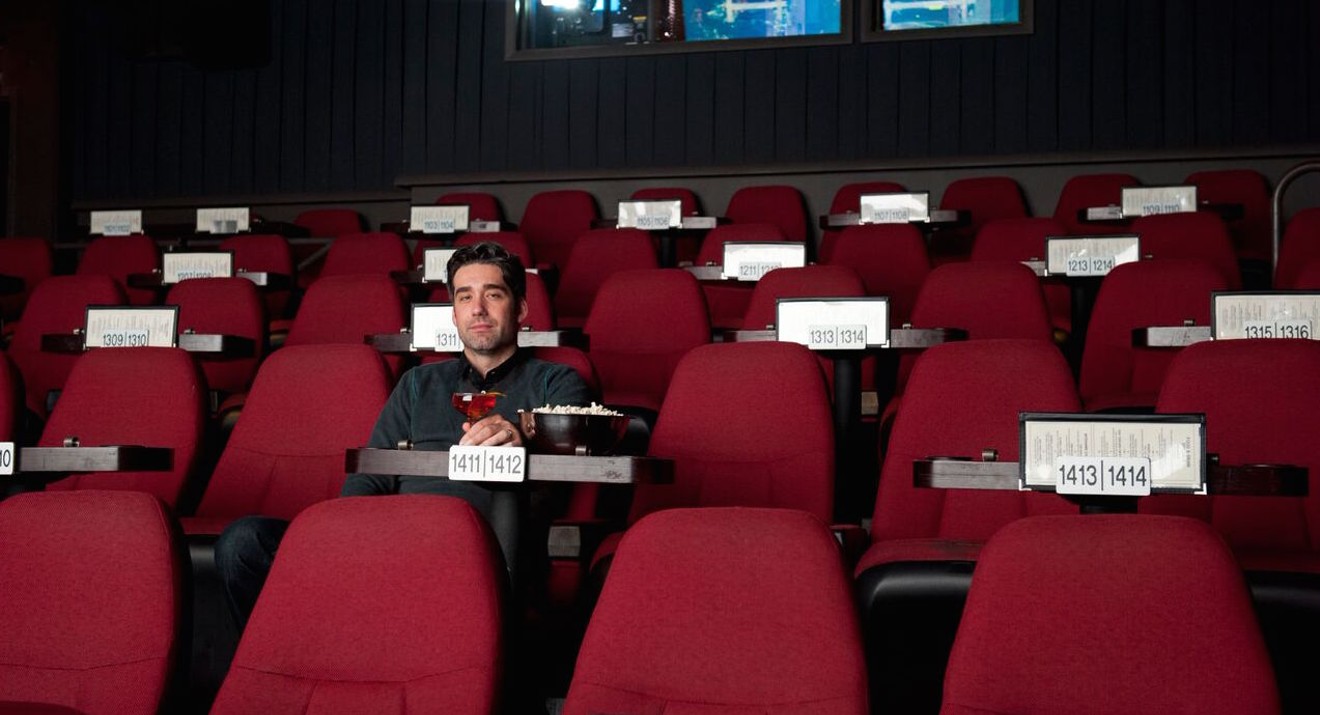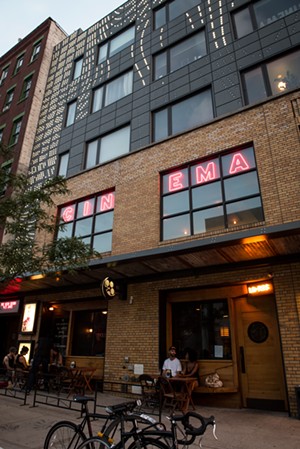“I’m all in on the theatrical experience," he said, speaking with a youthful eagerness and a relaxed candor. "I think there’s going to be more and more backlash on watching movies at home or on your phone.”
Upstairs, Nitehawk’s three theaters serve carefully curated drinks and meals, like a California Sangria for Lady Bird and the You’re Tearing Me Apart, Lisa flatbread for The Disaster Artist.
“It’s like a boutique hotel, almost, but even smaller,” Viragh said. “We use food and beverage to sort of get inspired and try to make connections with the movie through culinary creativity.”
Theaters like Nitehawk — boutique, independent cinemas — are a growing movement in the country, and they’re changing the way we experience movies. In New York City, Nitehawk was the first of its kind.
Viragh left Fort Worth in the late '90s to study advertising at the University of Texas. While in Austin, he discovered the country’s first Alamo Drafthouse, a single-screen cinema in a parking garage off Fourth Street. It left an impression on him, and he missed it when he moved to New York in 2002.
“Being from Texas, I was like, I want a fucking beer when I watch a movie, and I couldn’t do it,” he said.
New York’s Alcoholic Beverage Control laws prevented moviegoers from drinking alcohol. Buried in paperwork, Viragh found a Prohibition-era statute that motion picture theaters couldn’t legally sell alcohol — live theaters could, but not cinemas.
His plans for Nitehawk still took some time to develop. In 2008, he took an apprenticeship at The Commodore Theatre in Virginia, America’s first first-run cinema selling booze. Viragh decided to build a business plan.
When Nitehawk opened in 2011, the law still prohibited alcohol in cinemas. Nitehawk could only sell alcoholic drinks downstairs in the bar, and they couldn’t be brought into the movie."I see a lot of young people who tell me they typically don't go to the movies a lot, but they like coming here. They like hanging out here." – Tim Chung
tweet this
“It was really annoying, but it was such a novelty to even have a beer in the lobby of a movie theater up here,” Viragh said. “They would just slam it and go in. A lot of people falling asleep during the films back then.”
That year, he joined forces with a lobbyist in Albany who thought there was a chance to change New York's law, and together with Viragh’s lawyers, they wrote a new one.
“We wrote the law with lawmakers and our lobbyist and just tried to craft something that was reasonable for all parties, basically,” Viragh said.
It passed in the New York State Legislature and Gov. Andrew Cuomo signed it months after Nitehawk opened.
“My whole thing is trying to improve the moviegoing experience in New York, Viragh says. "Our premise was, look, everyone’s doing this all over the country. And it’s a way for single-screen theaters, independent smaller places, to be able to drive more revenue and save themselves. See if they can make a go at it so you don’t lose movie theaters.”
By pioneering the new law, Viragh opened the door for a slew of new cinemas in New York. He even paved the way for his inspiration, Alamo Drafthouse, to enter the market. But as he sips his Sorachi Ace in the dimly lit restaurant, he says he likes Alamo being here.
“There’s plenty of room in the city, man. It’s giant. Especially Brooklyn. It’s underserved," he says. "The whole exhibition scene hadn’t evolved in years. It’s taken a long time to even get here.”
This year, movie theaters were plagued by sinking attendance across the country. National ticket sales are almost $2 billion behind 2016 sales, yet Nitehawk, Alamo Drafthouse and other boutique cinemas seem impervious to the setback.
For example, Nitehawk is opening a seven-screen, 650-seat multiplex next year in Park Slope, Brooklyn. Alamo Drafthouse is rapidly expanding across the country, and in addition to Alamo, two boutique cinema-eateries popped up in New York City last year: Syndicated Theatre in Bushwick and Metrograph in Chinatown.
Tim Chung, a managing partner at Syndicated Theatre, says he saw Nitehawk in 2011.
“Once Nitehawk opened, I thought, ‘Oh shit. We have to do something now,’” he says. Like Viragh, Chung was inspired by Alamo Drafthouse, and he asked himself, “Why doesn’t this exist in New York?”
Howard Besser, a director at the Moving Image Archive and Preservation Program at New York University, said the success of these cinemas is a dual threat. First, they’re fostering to an interested community by showing old, 35mm films that have yet to be digitized.
“In a commercial theater, most people are there for entertainment as a distraction," Besser says. "In these micro-cinemas, most of the people there are serious cinema fans.”
The cinemas also offer exposure to newer patrons, which Chung says happens frequently.
“I see a lot of young people who tell me they typically don’t go to the movies a lot, but they like coming here. They like hanging out here,” he says.
That was Viragh’s goal from the beginning: to craft an experience, not just project a film. Because of places like Alamo, Nitehawk and Syndicated, he still believes in the power of cinemas.
“There are particular movies you need to see in the theater with people, and I want that commonality between the audience and food and drink," he says. "It’s a full experience. It’s tangible. Movies are here to stay, man.”

When Nitehawk Cinema first opened, drinks were only available in the lobby bar.
courtesy Nitehawk Cinema












